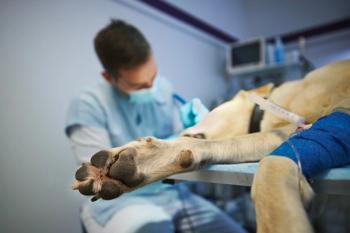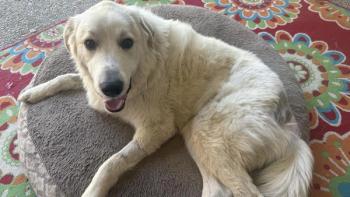
On the Forefront: Studying the effects of polyethylene glycol in dogs with acute spinal cord injuries
If you know of an eligible candidate, Iowa State University will be accepting dogs into the study beginning in March 2005.
Spinal cord injury is common in both dogs and people. A high incidence of acute intervertebral disk rupture occurs in dogs, particularly the chondrodystrophic breeds, such as dachshunds, Pekingese, Lhasa apsos, Shih Tzus, cocker spaniels, and crosses of these breeds. The prolapsed disk focally compresses the spinal cord and can result in irreversible loss of voluntary motor activity and central recognition of pain (conscious pain perception).
Rags is recuperating from a thoracolumbar hemilaminectomy. Dogs that have had a recent acute intervertebral disk herniation may be able to participate in a clinical trial evaluating the efficacy of adjunct therapy with polyethylene glycol in treating spinal cord injury.
In dogs, explosive disk herniation closely mimics the anatomical response of human spinal cords to severe compression injury.1-4 Multiple therapeutic modalities have been described in both species, including surgical decompression, drug therapy (e.g. injectable corticosteroids such as methylprednisolone sodium succinate, prednisolone sodium succinate, and the 21-aminosteroids [lazaroids], as well as dimethyl sulfoxide), oscillating field stimulation, and alternative therapies (e.g. acupuncture) or combinations thereof.5,6
The Department of Veterinary Clinical Sciences at the Iowa State University College of Veterinary Medicine, in collaboration with the Center for Paralysis Research at Purdue University, is continuing a promising multi-institutional study that was recently reported in the Journal of Neurotrauma. That preliminary study (conducted through the Departments of Veterinary Clinical Sciences at Purdue University and Texas A&M University, the Department of Neurosurgery at Indiana University Medical Center, and the Department of Biomedical Engineering and the Center for Paralysis Research at Purdue University) involved the use of intravenous surfactants to treat dogs with acute paraplegia.3 The hydrophilic polymers investigated were polyethylene glycol and poloxamer 188. Such polymers have been shown to seal defects in axonal cell membranes and are theorized to help prevent secondary tissue death that can occur subsequent to initial injury. These polymers have been investigated in standardized experiments involving spinal cord injury in guinea pigs at the Center for Paralysis Research at Purdue University.7-12
The recent multi-institutional study mentioned above and the continuing investigation at Iowa State University involve the use of intravenously administered polyethylene glycol to help reunite and fuse transected cell processes and to seal anatomical breaches in cell membranes produced by mechanical insult to the spinal cord tissue.7 The results of the preliminary investigation were encouraging, but further investigation is warranted.
The study details
The purpose of the polyethylene glycol study at Iowa State University is to further characterize the benefits of this treatment in a larger number of dogs with naturally occurring, neurologically complete (posterior paralysis and loss of conscious pain perception) spinal cord injury secondary to intervertebral disk rupture. To be enrolled in this double blind prospective study, dogs must:
1. Be between the ages of 1 and 10 years
2. Weigh less than 50 lb (22.7 kg)
3. Be free of concurrent life-threatening illnesses
4. Be presented to Iowa State University's veterinary neurology section within 72 hours of the onset of the posterior paralysis
5. Have a neurologically complete injury (i.e. a T3-L3 spinal cord lesion secondary to suspected intervertebral disk herniation resulting in paraplegia and absence of conscious pain perception in the hindlimbs)
Each dog will be evaluated with a thorough physical examination, a digitally recorded neurologic examination, a complete blood count, a serum chemistry profile, and a urinalysis. After this initial evaluation, each dog will be anesthetized, and an electrodiagnostic procedure called a somatosensory evoked response, which evaluates spinal cord integrity between the limbs and the brain, will be performed. After this procedure, an intravenous dose of either polyethylene glycol or a control solution of sterile saline will be administered in a random fashion to each study participant. Myelography and a hemilaminectomy and durotomy will then be performed. Four to six hours after the initial injection, another injection of the polyethylene glycol or the sterile saline will be given.
Postoperatively, digitally recorded neurologic examinations will be performed at three and seven days, and a repeat somatosensory evoked response procedure will be performed one week after surgery. Neurologic examinations will be repeated at six to eight weeks and six months after surgery. All study-related medical and surgical costs incurred for the dogs enrolled will be paid for by the study.
Know of a study candidate?
If you know of an eligible candidate, the veterinary neurology section at Iowa State University will be accepting dogs into the study beginning in March 2005. It is hoped that the findings of this study using polyethylene glycol will be positive and that this will stimulate expanded therapeutic use of this polymer in the treatment of spinal cord injury in both dogs and people.
Contact information for this study as well as answers to frequently asked questions regarding case eligibility can be found on the Iowa State University College of Veterinary Medicine neurology section Web site; or contact Dr. Karen Kline at (515) 294-4900 (e-mail
The information and photograph for "On the Forefront" were provided by Karen L. Kline, DVM, MS, DACVIM (neurology), Department of Veterinary Clinical Sciences, College of Veterinary Medicine, Iowa State University, Ames, IA 50011.
REFERENCES
1. Coates JR. Intervertebral disk disease. Vet Clin North Am Small Anim Pract 2000;30:77-110.
2. Coates JR, Sorjonen DC, Simpson ST, et al. Clinicopathologic effects of a 21-aminosteroid compound (U74389G) and high-dose methylprednisolone on spinal cord function after simulated spinal cord trauma. Vet Surg 1995;24:128-139.
3. Laverty PH, Leskovar A, Breur GJ, et al. A preliminary study of intravenous surfactants in paraplegic dogs: Polymer therapy in canine clinical SCI. J Neurotrauma 2004;21:1767-1777.
4. Hoerlein BF. Comparative disk disease: Man and dog. J Am Anim Hosp Assoc 1979;15:535-545.
5. Borgens RB, Toombs JP, Breur G, et al. An imposed oscillating electrical field improves the recovery of function in neurologically complete paraplegic dogs. J Neurotrauma 1999;16:639-657.
6. Borgens RB, Toombs JP, Blight AR, et al. Effects of applied electrical fields on clinical cases of complete paraplegia in dogs. Restor Neurol Neurosci 1993;5:305-322.
7. Borgens RB, Bohnert D. Rapid recovery from spinal cord injury after subcutaneously administered polyethylene glycol. J Neurosci Res 2001;66:1179-1186.
8. Borgens RB, Bohnert D, Duerstock B, et al. Subcutaneous tri-block copolymer produces recovery from spinal cord injury. J Neurosci Res 2004;76:141-154.
9. Duerstock BS, Borgens RB. Three-dimensional morphometry of spinal cord injury following polyethylene glycol treatment. J Exp Biol 2002;205:13-24.
10. Luo J, Borgens R, Shi R. Polyethylene glycol immediately repairs neuronal membranes and inhibits free radical production after acute spinal cord injury. J Neurochem 2002;83:471-480.
11. Borgens RB, Shi R, Bohnert D. Behavioral recovery from spinal cord injury following delayed application of polyethylene glycol. J Exp Biol 2002;205:1-12.
12. Shi R, Borgens RB, Blight AR. Functional reconnection of severed mammalian spinal cord axons with polyethylene glycol. J Neurotrauma 1999;16:727-738.
Newsletter
From exam room tips to practice management insights, get trusted veterinary news delivered straight to your inbox—subscribe to dvm360.






